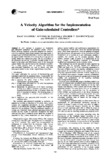Active Control of Adaptive Optics System in a Large Segmented Mirror Telescope
Abstract
For a large Adaptive Optics (AO) system such as a large Segmented Mirror Telescope (SMT), it is often difficult, although not impossible, to directly apply common Multi-Input Multi-Output (MIMO) controller design methods due to the computational burden imposed by the large dimension of the system model. In this paper, a practical controller design method is proposed which significantly reduces the system dimension for a system where the dimension required to represent the dynamics of the plant is much smaller than the dimension of the full plant model. The proposed method decouples the dynamic and static parts of the plant model by a modal decomposition technique to separately design a controller for each part. Two controllers are then combined using so-called Sensitivity Decoupling Method (SDM) so that the resulting feedback loop becomes the superposition of the two individual feedback loops of the dynamic and static parts. A MIMO controller was designed by the proposed method using the Hloop shaping technique for an SMT model to be compared with other controllers proposed in the literature. Frequency-domain analysis and time-domain simulation results show the superior performance of the proposed controller.
For a large Adaptive Optics (AO) system such as a large Segmented Mirror Telescope (SMT), it is often difficult, although not impossible, to directly apply common Multi-Input Multi-Output (MIMO) controller design methods due to the computational burden imposed by the large dimension of the system model. In this paper, a practical controller design method is proposed which significantly reduces the system dimension for a system where the dimension required to represent the dynamics of the plant is much smaller than the dimension of the full plant model. The proposed method decouples the dynamic and static parts of the plant model by a modal decomposition technique to separately design a controller for each part. Two controllers are then combined using so-called Sensitivity Decoupling Method (SDM) so that the resulting feedback loop becomes the superposition of the two individual feedback loops of the dynamic and static parts. A MIMO controller was designed by the proposed method using the Hloop shaping technique for an SMT model to be compared with other controllers proposed in the literature. Frequency-domain analysis and time-domain simulation results show the superior performance of the proposed controller.
For a large Adaptive Optics (AO) system such as a large Segmented Mirror Telescope (SMT), it is often difficult, although not impossible, to directly apply common Multi-Input Multi-Output (MIMO) controller design methods due to the computational burden imposed by the large dimension of the system model. In this paper, a practical controller design method is proposed which significantly reduces the system dimension for a system where the dimension required to represent the dynamics of the plant is much smaller than the dimension of the full plant model. The proposed method decouples the dynamic and static parts of the plant model by a modal decomposition technique to separately design a controller for each part. Two controllers are then combined using so-called Sensitivity Decoupling Method (SDM) so that the resulting feedback loop becomes the superposition of the two individual feedback loops of the dynamic and static parts. A MIMO controller was designed by the proposed method using the Hloop shaping technique for an SMT model to be compared with other controllers proposed in the literature. Frequency-domain analysis and time-domain simulation results show the superior performance of the proposed controller.
For a large Adaptive Optics (AO) system such as a large Segmented Mirror Telescope (SMT), it is often difficult, although not impossible, to directly apply common Multi-Input Multi-Output (MIMO) controller design methods due to the computational burden imposed by the large dimension of the system model. In this paper, a practical controller design method is proposed which significantly reduces the system dimension for a system where the dimension required to represent the dynamics of the plant is much smaller than the dimension of the full plant model. The proposed method decouples the dynamic and static parts of the plant model by a modal decomposition technique to separately design a controller for each part. Two controllers are then combined using so-called Sensitivity Decoupling Method (SDM) so that the resulting feedback loop becomes the superposition of the two individual feedback loops of the dynamic and static parts. A MIMO controller was designed by the proposed method using the Hloop shaping technique for an SMT model to be compared with other controllers proposed in the literature. Frequency-domain analysis and time-domain simulation results show the superior performance of the proposed controller.
For a large Adaptive Optics (AO) system such as a large Segmented Mirror Telescope (SMT), it is often difficult, although not impossible, to directly apply common Multi-Input Multi-Output (MIMO) controller design methods due to the computational burden imposed by the large dimension of the system model. In this paper, a practical controller design method is proposed which significantly reduces the system dimension for a system where the dimension required to represent the dynamics of the plant is much smaller than the dimension of the full plant model. The proposed method decouples the dynamic and static parts of the plant model by a modal decomposition technique to separately design a controller for each part. Two controllers are then combined using so-called Sensitivity Decoupling Method (SDM) so that the resulting feedback loop becomes the superposition of the two individual feedback loops of the dynamic and static parts. A MIMO controller was designed by the proposed method using the Hloop shaping technique for an SMT model to be compared with other controllers proposed in the literature. Frequency-domain analysis and time-domain simulation results show the superior performance of the proposed controller.
For a large Adaptive Optics (AO) system such as a large Segmented Mirror Telescope (SMT), it is often difficult, although not impossible, to directly apply common Multi-Input Multi-Output (MIMO) controller design methods due to the computational burden imposed by the large dimension of the system model. In this paper, a practical controller design method is proposed which significantly reduces the system dimension for a system where the dimension required to represent the dynamics of the plant is much smaller than the dimension of the full plant model. The proposed method decouples the dynamic and static parts of the plant model by a modal decomposition technique to separately design a controller for each part. Two controllers are then combined using so-called Sensitivity Decoupling Method (SDM) so that the resulting feedback loop becomes the superposition of the two individual feedback loops of the dynamic and static parts. A MIMO controller was designed by the proposed method using the Hloop shaping technique for an SMT model to be compared with other controllers proposed in the literature. Frequency-domain analysis and time-domain simulation results show the superior performance of the proposed controller.
Rights
This publication is a work of the U.S. Government as defined in Title 17, United States Code, Section 101. Copyright protection is not available for this work in the United States.Related items
Showing items related by title, author, creator and subject.
-
Adaptive Speed Controller for the SeaFox Autonomous Surface Vessel
Hurban, Michael A. (Monterey, California. Naval Postgraduate School, 2012-03);The thesis addressed the control system development for a high-speed surface vessel. In particular, the work utilized modern adaptive control techniques to design a speed following controller for the SeaFox ASV; the vehicle ... -
A Velocity Algorithm for the Implementation of Gain-scheduled Controllers
Kaminer, Isaac; Pascoal, Antonio M.; Khargonekar, Pramod P.; Coleman, Edward E. (Elsevier Science Ltd, 1995);A new method is proposed to implement gain-scheduled controllers for nonlinear plants. Given a family of linear feedback controllers designed for linearizations of a nonlinear plant about constant operating points, ... -
A Veolicty Algorithm for the Implementation of Gain-scheduled Controllers
Kaminer, Isaac; Pascoal, Antonio M.; Khargonekar, Pramod P.; Coleman, Edward E. (1995);new method is proposed to implement gain-scheduled controllers for nonlinear plants. Given a family of linear feedback controllers designed for Iinearizations of a nonlinear plant about constant operating points, ...



 IJSS_SMT_control_NAGASHIMA_fin.pdf (1.189Mb)
IJSS_SMT_control_NAGASHIMA_fin.pdf (1.189Mb)

